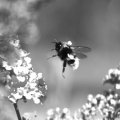A new multi-media software program which could help make serious inroads into the problem of classifying and identifying the world's rich biodiversity has been released for teachers, students and researchers.
Dr David Yeates of the University of Queensland's Entomology Department and programmers Greg Rutter and Dan Marzano of the Cooperative Research Centre for Tropical Pest Management have developed an interactive Windows program known as LucID.
The CD-ROM program is designed to assist people without expertise in computers or taxonomy to identify organisms. LucID can be applied to living things, from insects to trees, or to objects such as rocks or cars.
'It's a true multi-media program which can incorporate images, sound and videos, as well as text to help users reach the correct identification,' Dr Yeates said.
The University of Queensland has developed keys to insects and fungi, and is developing keys to butterflies, pond life and rock pool life.
CSIRO's Division of Entomology in Canberra has already adapted LucID to produce a tool for identifying Australian aquatic invertebrates. A key to Australia's Eucalyptus species is being developed by Dr Kevin Thiele of CSIRO's Centre for Plant Biodiversity Research.
The program teaches students how to identify specimens using an interactive multimedia approach which is easier to use than traditional text-based, identification keys.
Dr Yeates said LucID would benefit secondary school students, undergraduates, ecologists and professional taxonomists. The Queensland science curriculum for Years 1 to 10 has already identified the program as a useful resource.
He said the program had already proved popular with his second and third-year university students learning how to identify and classify insects.
'Each year these students are confronted with the traditional print-based keys to insects which require a detailed understanding of the technical terms used to classify insects,' he said.
'A multi-media approach makes life easier for them, because it allows students to access pictures or definitions which increase the accuracy of their identifications. Also, the interactive key is quicker to use, as it requires fewer steps than traditional keys.
"The importance of an easy-to-use key for classifying organisms becomes evident when you consider that there may be somewhere between 10 and 30 million species on the planet, yet we know very little or nothing about the majority of them.
"In fact, scientists have only given names to one and a half million species. Identifying organisms has traditionally been left only to a handful of experts in each group. In a way, a LucID key enables us to crystallise, clone and distribute the knowledge of experts to the community.'
The LucID player, which is already available, sells for $50. A component of the program under development which helps teachers and researchers to design and build identification systems for any groups of organisms will be released later this year for $250. Both modules will be available with a plain English user manual, while on-line help is provided within the program.
For information on LucID and other multi-media software programs, contact Peter Stevens at the Co-operative Research Centre for Tropical Pest Management (telephone 07 3365 1574; email: p.stevens@ctpm.uq.edu.au) or visit the World Wide Web program demonstration site: (http://www.ctpm.uq.edu.au/software/software.html).
Media contacts: Larissa Bilson telephone 07 3365 1860, email larissa@ctpm.uq.edu.au, or Dr David Yeates, telephone 07 3365 2217, email: d.yeates@mailbox.uq.edu.au.



